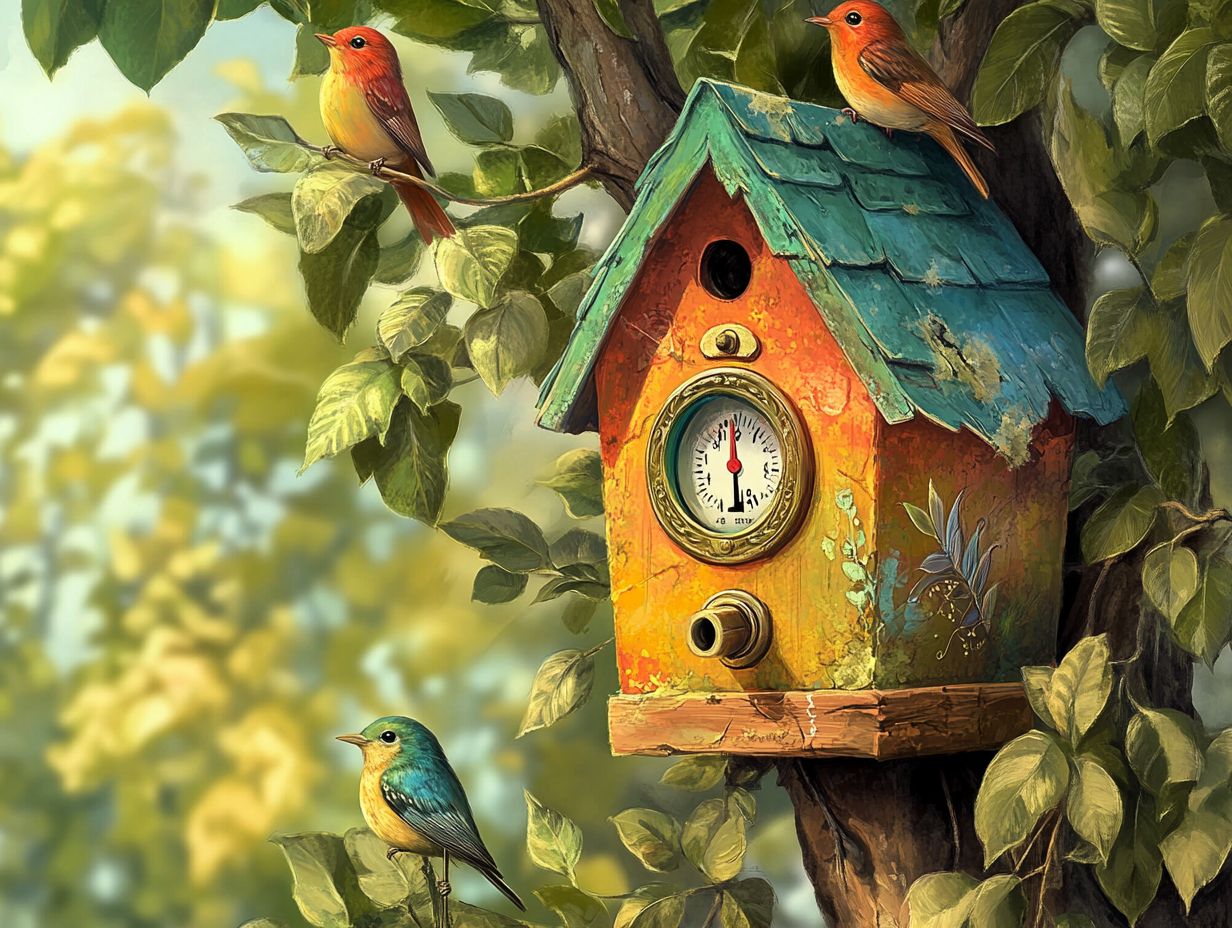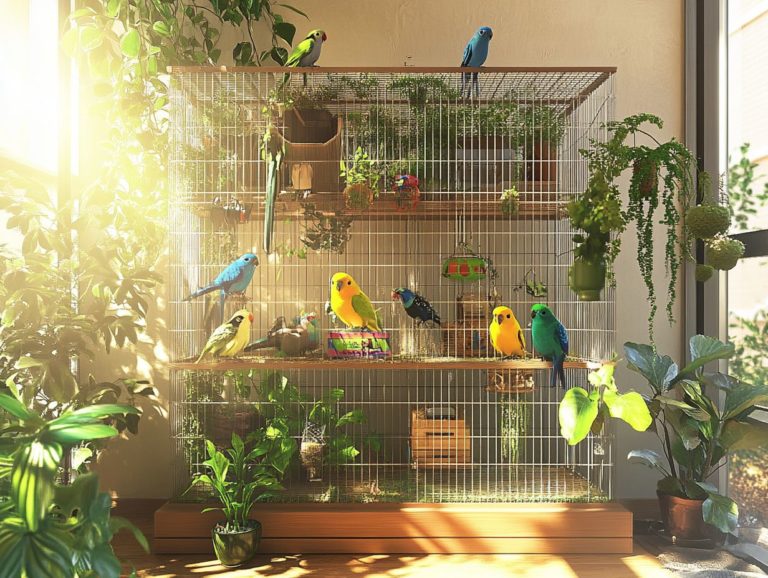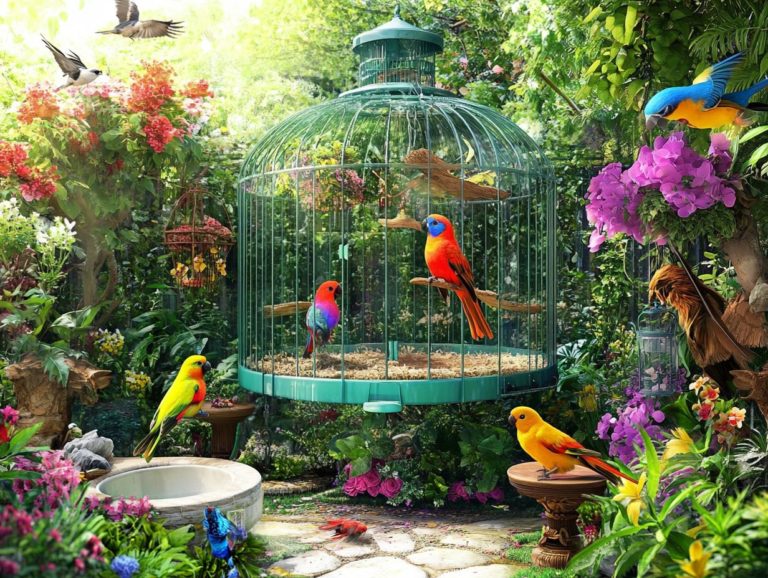The Ideal Temperature for Bird Housing
Birds possess a remarkable sensitivity to their environment, with temperature significantly influencing their overall well-being. As a bird owner, understanding the effects of temperature on their health and behavior is vital in creating a suitable habitat for your pets.
Get ready to discover how to keep your birds happy and healthy! This guide provides insights into the recommended temperature range for bird housing, exploring factors that vary by species, such as parrots, cockatiels, and conures. You ll also learn effective methods to maintain an optimal indoor temperature.
This guide also highlights signs of temperature-related issues, including lethargy or excessive vocalization, and offers solutions to address them, ensuring your feathered companions thrive in a comfortable and nurturing indoor environment.
Contents
- Key Takeaways:
- Understanding the Importance of Temperature for Birds
- Recommended Temperature Range for Bird Housing
- Ways to Maintain the Ideal Temperature for Birds
- Signs of Temperature-Related Issues in Birds
- Additional Factors to Consider for Different Bird Species
- Frequently Asked Questions
- What is the ideal temperature for bird housing?
- How can I maintain the ideal temperature for my bird housing?
- What happens if the temperature in my bird housing is too low?
- Can the ideal temperature for bird housing vary depending on the season?
- What are some signs that the temperature in my bird housing is too high?
- Are there any other factors besides temperature that can affect the well-being of pet birds in a housing environment?
Key Takeaways:

- Birds are highly sensitive to temperature and require a controlled environment for optimal health and behavior.
- The recommended temperature range for bird housing is between 65-75 F, but factors like humidity and air circulation should also be considered.
- To maintain the ideal temperature, heating and cooling options such as space heaters and fans can be used. Regularly monitoring and addressing any temperature-related issues is crucial for a bird’s well-being.
Understanding the Importance of Temperature for Birds
Understanding the importance of temperature for your birds is crucial as it has a profound effect on their health and behavior, influencing how they get used to varying conditions. Birds are exceptionally sensitive to changes in their environment, requiring specific temperature ranges to thrive. Keeping your birds in the right temperature range can prevent serious health issues like heat stroke, which means overheating, or hypothermia, which refers to being too cold.
Different species, like parrots, cockatiels, and macaws, have unique temperature needs. Therefore, it’s essential to create a safe and comfortable indoor environment suited for each species’ requirements. This guide will delve into the critical temperature factors, such as humidity and seasonal variations, that can significantly influence the well-being of your feathered companions.
Impact on Health and Behavior
How temperature affects the health and behavior of birds is profound, influencing everything from their feathers to their overall well-being, especially during extreme conditions.
When faced with extreme temperatures, you may notice significant shifts in their behavior, including increased aggression or lethargy. In cold conditions, birds often fluff up their feathers to trap heat, a classic sign that they aren t comfortable. Conversely, during scorching heat, they tend to seek shade or pant to cool themselves down. If birds aren t adjusted to sudden temperature changes, they can experience serious health issues like hypothermia or heat stroke, which can linger and impact their vitality, particularly in fluctuating seasonal conditions.
Being observant of these signs is crucial. Getting used to varying temperatures is key to their survival and overall health, enabling them to adapt seamlessly to seasonal shifts in their environment and ensuring their comfort and well-being.
Recommended Temperature Range for Bird Housing
Each bird species has its own ideal temperature range that you should strive to maintain for optimal health and comfort in indoor spaces, generally falling between 65 and 80 degrees Fahrenheit, especially when considering humidity levels and air circulation.
Factors to Consider

When figuring out the perfect temperature for your bird’s housing, consider several key factors. These include the specific species of your bird, such as tropical or temperate species, humidity levels, and the overall indoor environment. For more detailed information, check out what is the ideal temperature for pet birds?
Different bird species have unique preferences. For instance, tropical birds thrive in warmer conditions, while temperate species such as cockatiels prefer cooler settings. Humidity is crucial for their comfort; too much can lead to respiratory problems, while too little may cause dehydration, affecting their health.
Take a closer look at your indoor setup. Things like windows, cages, and heating sources can create unwanted drafts or hotspots. By thoughtfully assessing all these elements, you can create a stable environment that promotes your bird s overall well-being and happiness.
Ways to Maintain the Ideal Temperature for Birds
To maintain the perfect temperature for your birds, employ a thoughtful blend of heating and cooling strategies. These may include daily misting and creating a comfortable indoor environment tailored to their needs.
Heating and Cooling Options
You have various heating and cooling options to keep your feathered friends comfortable. These include safe space heaters, cooling fans, and daily misting routines.
Explore diverse heating and cooling options now to keep your birds happy! Consider heat lamps, cooling fans, and humidity controls, which are essential for a stable indoor environment. Heat lamps provide targeted warmth during colder months, but monitor the distance to prevent overheating. Cooling fans enhance airflow, helping to prevent overheating in warmer climates; avoid directing airflow straight at your birds.
Humidity controls are essential for maintaining moisture levels, vital for your birds’ respiratory health. No matter which option you select, prioritize safety precautions. Ensure that your electrical setups are sound and avoid exposing your birds to drafts.
Signs of Temperature-Related Issues in Birds
Recognizing the signs of temperature issues is vital. This helps you take prompt action to protect your birds’ health and safety.
Identifying and Addressing Problems

Identifying and addressing temperature-related issues in birds requires keen observation and swift action. Birds are particularly sensitive to temperature fluctuations, making it essential for you to monitor your feathered companions closely, especially during extreme weather.
Changes in behavior, such as increased lethargy, excessive vocalization, or fluffed-up feathers, can indicate discomfort caused by extreme heat or cold. To remedy these issues, provide a stable and suitable environment, along with proper hydration and nutrition.
Expert avian veterinarians, like Gregory Burkett, DVM, and Larry Nemetz, DVM, often suggest creating a temperature range in their enclosure, allowing birds to find their preferred temperature zone. Providing access to shaded areas during hot days and using safe heating sources in cold conditions can help maintain their well-being and comfort. Regular check-ups are also vital for addressing any emerging health concerns.
Additional Factors to Consider for Different Bird Species
Different bird species have distinct temperature needs and considerations. It’s important to consider the unique humidity preferences of each species to ensure their health and comfort in indoor settings.
Ideal Temperatures for Your Favorite Birds
Popular bird species, such as parrots, cockatiels, conures, and macaws, have specific temperature needs that are crucial for their well-being and longevity. Understanding their natural habitats, like the tropical climates that parrots come from, will guide you in providing the right temperature ranges. For example, parrots thrive best in temperatures around 75-85 F (24-29 C). In contrast, cockatiels prefer cooler environments, ideally between 65-80 F (18-27 C). Larger birds like macaws favor warmer ranges around 70-90 F (21-32 C).
Maintaining stable temperatures is essential; drastic fluctuations can lead to stress or health issues. To help you create a suitable environment for your pet birds, resources like the American Bird Conservancy and the National Audubon Society provide excellent guidelines and insights tailored for bird owners.
Frequently Asked Questions
What is the ideal temperature for bird housing?

Different birds need different temperatures. Generally, aim for 65-75 F (18-24 C). Consider humidity levels and seasonal variations when setting up their living space. Research the specific needs of your bird species to help them get used to their ideal conditions, which is vital for their health.
How can I maintain the ideal temperature for my bird housing?
To keep your birds comfortable, you must have a reliable source of heat, such as a safe space heater or a heat lamp. Regularly monitor the temperature and humidity levels, adjusting as needed to create a cozy environment.
What happens if the temperature in my bird housing is too low?
If the temperature in your bird housing drops too low, it can harm your birds, leading to stress and potential health issues. They may become anxious, weakening their immune systems and making them more susceptible to illness, especially during extreme temperatures. Keeping the temperature within the ideal range is crucial for their health and comfort.
Can the ideal temperature for bird housing vary depending on the season?
Yes, you may need to adjust the temperature based on seasonal changes. In colder months, raise the temperature to keep your birds warm and comfortable indoors. During warmer months, you can lower the temperature slightly, as long as it stays within the recommended range, ensuring proper airflow and avoiding extreme heat.
What are some signs that the temperature in my bird housing is too high?
Signs that the temperature is too high include excessive panting, lethargy, and spreading of wings. If you notice these symptoms, you need to adjust the temperature right away to prevent overheating and ensure your birds remain safe and comfortable.
Are there any other factors besides temperature that can affect the well-being of pet birds in a housing environment?
Yes, humidity levels and ventilation are also crucial. Maintaining proper humidity and ensuring adequate airflow prevent respiratory issues and support your birds’ overall health, especially in extreme temperatures. Be aware of signs of cold or heat stroke, as both can affect their well-being. A comfortable habitat with appropriate cages and indoor temperature is essential for species like cockatiels, conures, and macaws, who thrive in both warm and cool conditions. Daily misting can help regulate humidity levels, while minimizing exposure to drafts keeps their feathers in good condition.






